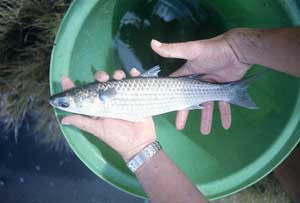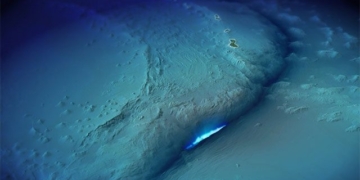The Mullet: An Overview of Its Characteristics and Cultivation
The mullet is a euryhaline species widely distributed in coastal waters of tropical and subtropical regions around the world. It is known as a popular fish due to its meat quality and affordability compared to more expensive fish species like grouper and snapper.
The mullet is also considered a valuable aquaculture species in Mediterranean countries such as Israel, Tunisia, Hong Kong, and Taiwan, due to its rapid growth and compatibility with other species. Additionally, mullet roe is a delicacy favored by the Chinese, making it an attractive focus for research since the 1960s. However, in Vietnam, this species has received little attention as a farming candidate, mainly being harvested from natural waters in coastal and brackish regions, resulting in limited research on the species.
1. Brief Overview of Mullet Biological Characteristics
The mullet family consists of a large number of species, with around 13 considered for aquaculture. The most notable species is Mugil cephalus due to its wide distribution, rapid growth, and large size when mature.
In Vietnam, there are 13 species of mullet, with at least 5 found in the southern region: M. cephalus, M. dussumieri (now known as Liza subviridis), Liza macrolepis, Liza vaigiensis, and Valamugil cunnesius. According to the Ministry of Fisheries (1996), 5-7 valuable species are commonly found in our river estuaries.
Mullet are euryhaline, thriving in brackish, saline, and freshwater environments. In subtropical regions, a study (Cardona, 2000) showed that juvenile mullet can tolerate temperatures as low as 10°C; however, there is little documentation on the effects of temperature on their growth and reproduction. Most studies on mullet have been conducted at temperatures ranging from 20-30°C.
During the larval to juvenile stages, mullet feed on zooplankton, and as they mature, they shift to a diet of phytoplankton, organic detritus, and benthic vegetation (lab-lab: a symbiosis between benthic algae and microorganisms). In aquaculture, fertilizers are applied to stimulate algal growth for natural food sources, and they can also be supplemented with rice bran, peanut cake, soybeans, or peanut meal.
Mullet from the mudflat, M. dussumieri, harvested in brackish waters of the Red River system, reach sizes of 135-195 cm (corresponding to 113-167g). The striped mullet, Liza soiny, reaches 280-370 cm, while the flathead mullet can reach 295-360 cm (Vu Trung Tang, 1994). In the Tam Giang lagoon (Hue), flathead mullet can reach sizes of 501 cm (1,120 g). Mullet mature at 2 years of age, with individuals showing gonadal development at stage IV; they spawn directly in the lagoon. Absolute fecundity ranges from 7,500 to 27,000 eggs. Striped mullet are only found with low-stage gonads (below stage III) (Vo Van Phu, 1995). M. cephalus grows faster than other mullet species. Females generally grow faster and reach larger sizes than males. Under farming conditions, they can achieve sizes of 300g after one year, 1.2 kg after two years, and over 2 kg after three years.
Mullet exhibit schooling behavior, especially during the breeding season, when they gather in large schools migrating to deeper waters for spawning. Mullet are seasonal spawners, with the breeding season lasting from October to April of the following year; however, in subtropical water bodies, the breeding season can be shorter (until January-February of the following year). Mullet reach reproductive maturity at 3 years of age, with average body lengths of approximately 33 cm for males and 35 cm for females. The reproductive capacity generally correlates with the fish’s weight and length; larger fish have higher fecundity. Females weighing around 1.5 kg can produce 1-1.5 million eggs (Pillay, 1990). Mullet eggs range from 0.9-1 mm in diameter, and fertilized eggs hatch into larvae within 16-30 hours at temperatures of 20-24°C. Newly hatched mullet larvae are very small (2.5-3.5 mm) and tend to avoid bright light. Both eggs and newly hatched larvae often drift offshore during certain times of the year (during the breeding months), with fry appearing seasonally in river estuaries where they serve as nursery grounds for juvenile fish.
2. Mullet Farming
 |
|
(Photo: ag.auburn) |
Typically, mullet are not farmed alone; they are often raised in conjunction with other species such as catfish and snapper, achieving average yields of 400 kg/ha in India. In Hong Kong, Taiwan, and Israel, mullet are commonly co-cultured with Chinese carp, with mullet being the primary species. Stocking densities can reach 10,000-15,000/ha (for fish sized at 7.5 cm) along with 1,000-2,000 Chinese carp. Once they grow larger (12 cm), mullet are selectively harvested, leaving approximately 3,500 fish/ha. The feed provided consists of rice bran (for the first two months) and subsequently peanut cake and rice bran. Additionally, organic fertilizers are applied to enhance the natural food supply in the ponds. Yields range from 2,500 to 3,500 kg/ha.
In Taiwan, mullet are co-cultured with catfish (2,000 fish/ha), Chinese carp (3,250 fish/ha), and common carp (500 fish/ha) at a density of 3,000 fish/ha. They reach 300g after one year and 1.2 kg after two years. Moreover, mullet can be co-cultured with tilapia, common carp, and silver carp, with a total density of about 12,300 fish/ha. After four months of farming, mullet can reach 100g. In farming for meat, female mullet typically grow faster than males, and their eggs are used in specialty food preparations; thus, steroids (such as 17α-Methyltestosterone and Ethynyl estradiol) have also been used through feed to control the sex differentiation of mullet.


















































